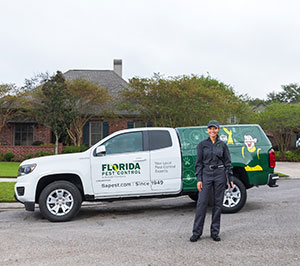A1 Pest Control Portland Bed Bugs - Specialist Elimination Provider
Wiki Article
Effective Parasite Control Providers: An Extensive Look at Extermination Techniques and Avoidance Steps
In the realm of insect control services, the successful administration of infestations requires a thorough technique that combines various methods and measures for both removal and avoidance. From Integrated Pest Administration (IPM) methods that focus on lasting solutions to chemical extermination methods made for targeted elimination, the arsenal versus pests is large and complex.
Integrated Parasite Management (IPM) Methods
Integrated Pest Management (IPM) Techniques incorporate a comprehensive approach to pest control that concentrates on surveillance, control, and prevention approaches to successfully manage pest populations. By incorporating various methods, IPM intends to minimize the influence of insects while also minimizing the reliance on chemical pesticides. Prevention lies at the core of IPM, highlighting practices like correct sanitation, maintenance of health, and sealing entry points to hinder bugs from infesting buildings. Tracking plays an essential role in IPM by routinely identifying and inspecting bug levels to figure out the appropriate intervention limits. Control techniques in IPM prioritize the use of physical, biological, and social strategies prior to turning to chemical therapies as a last hotel. These strategies include presenting all-natural predators, habitat alteration, and employing capturing gadgets to maintain insect populaces in check. Overall, IPM fosters a lasting and eco conscious technique to pest management, advertising lasting options that protect both human health and the environment.Chemical Elimination Techniques
Chemical elimination techniques are frequently used in parasite control solutions to efficiently eradicate pest populaces that position a hazard to human health and wellness and building. These methods include the usage of different chemical substances specifically made to target and remove insects such as insects, rodents, and other undesirable animals. The application of pesticides, insecticides, rodenticides, and various other chemical representatives is carefully managed to ensure maximum effectiveness while lessening risks to human beings, pets, and the atmosphere.Among the essential advantages of chemical extermination techniques is their capacity to give quick and targeted results, making them especially helpful in instances of severe infestations or urgent insect control demands - a1 portland bed bug exterminator. Nonetheless, it is important to highlight the value of appropriate handling, application, and disposal of these chemical products to stop unplanned damage
Furthermore, integrated pest administration (IPM) approaches commonly incorporate chemical elimination strategies with other techniques such as sanitation, environment alteration, and biological controls to develop a detailed and sustainable insect control technique. By incorporating chemical elimination methods sensibly within an IPM structure, insect control services can properly handle bug populations while reducing prospective risks to human health and the environment.
Biological Parasite Control Techniques
Using all-natural predators and parasites to take care of pest populaces is a lasting approach recognized as organic pest control. This technique harnesses the all-natural devices of the community to regulate bug populations without depending on synthetic chemicals. One typical biological control method includes introducing natural adversaries of the target parasite species, such as ladybugs for aphid control or nematodes for termite infestations. These all-natural killers prey on the parasites, assisting to maintain their populations in check.One more effective organic control approach is making use of microbial insecticides. These are normally occurring microorganisms, such as fungi, microorganisms, and viruses, that specifically target and infect specific bug species. By making use of these microbial representatives, insect populations can be properly decreased without damaging useful microorganisms or causing damage to the setting.
Physical Insect Avoidance Actions
Implementing physical parasite avoidance actions entails utilizing obstacles and structural adjustments to discourage pests from infesting a property or going into. Mounting door sweeps, screens on home windows, and securing fractures in the foundation can assist stop bugs like pests and rats from acquiring gain access to inside.An additional physical avoidance measure is making use of barriers like secure fencing to maintain larger bugs such as raccoons or deer away from the residential property. Mounting mesh or cord displays around gardens can shield plants from being harmed by bugs. Appropriate waste management, including safeguarding wastebasket with tight-fitting covers, is vital in deterring pests like rats, raccoons, and bugs. By executing these physical bug avoidance steps, property owners can substantially minimize the risk of bug infestations and the damage they can trigger.
Expert Insect Inspection Procedures
Conducting systematic and complete insect evaluations is a fundamental facet of specialist parasite administration protocols. Expert bug examiners are trained to thoroughly examine properties for indications of problems, determining pest types, access points, and favorable conditions. The assessment procedure normally starts with a thorough evaluation of both the exterior and interior of the premises. This entails monitoring for bug droppings, munch marks, nests, and any architectural damage that may show parasite activity. In addition, inspectors may use specific tools such as moisture meters and borescopes to find hidden invasions within wall surfaces or crawl spaces.
Conclusion
To conclude, effective parasite control services use a variety of strategies, consisting of Integrated Bug Administration techniques, chemical elimination methods, biological controls, and physical avoidance steps. Expert bug inspection treatments a1 pest control in portland oregon bed bugs play an important duty in determining and addressing pest issues in a prompt manner. By carrying out a mix of these techniques, home proprietors can effectively stop and manage pest problems.From Integrated Insect Management (IPM) methods that focus on sustainable remedies to chemical elimination methods designed for targeted elimination, the arsenal versus parasites is huge and diverse.Integrated Insect Administration (IPM) Methods encompass a thorough technique to pest control that concentrates on tracking, avoidance, and control approaches to effectively manage bug populaces.Chemical extermination methods are typically used in parasite control services to effectively eliminate bug populations that position a danger to human health and building.Using all-natural predators and parasites to handle insect populaces is a lasting method known as organic parasite control.In final thought, efficient insect control services employ a range of techniques, including Integrated Parasite Management methods, chemical elimination techniques, organic controls, and physical prevention measures.
Report this wiki page